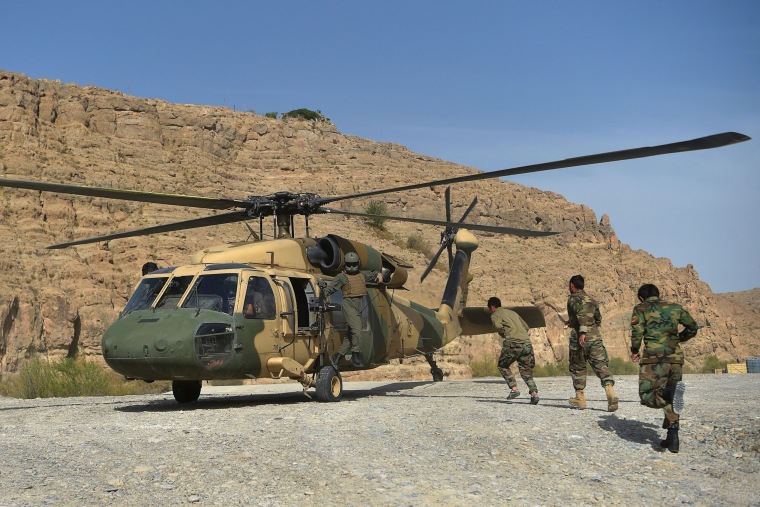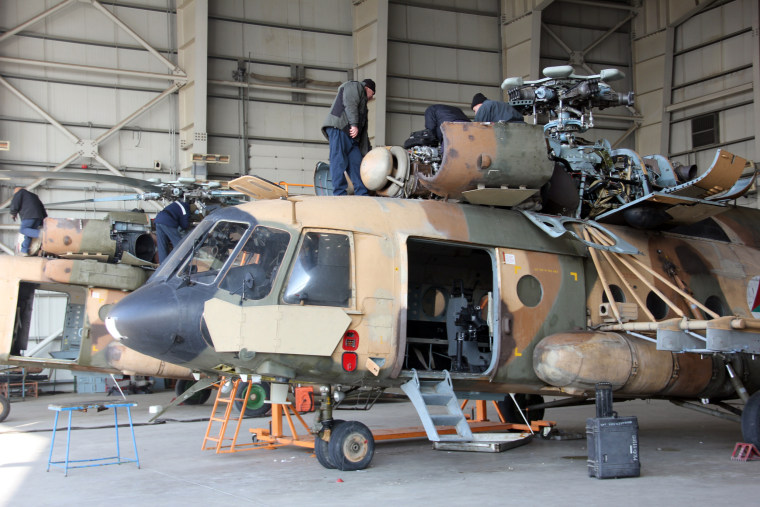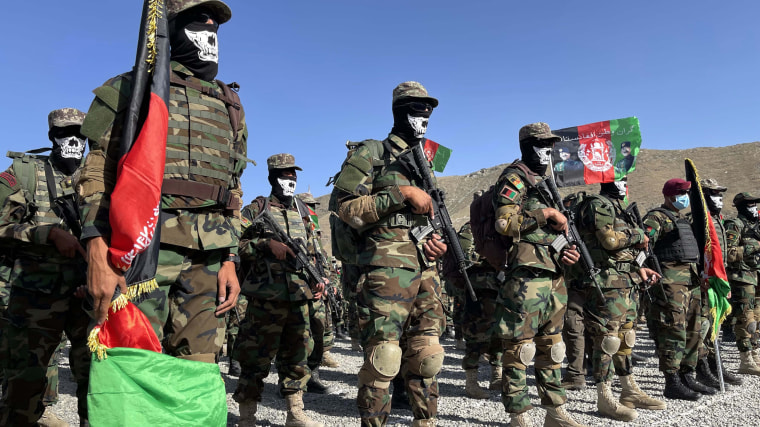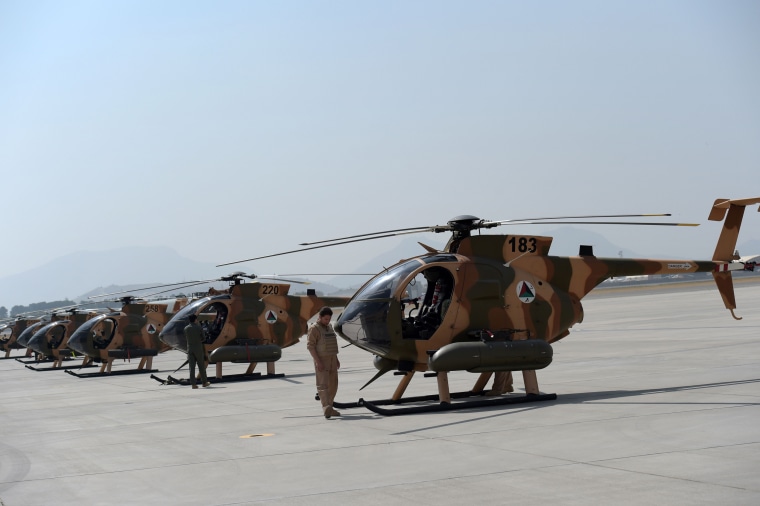WASHINGTON — Afghan government forces could lose the single most important military advantage they have over the Taliban — air power — when private contractors and U.S. troops leave the country in coming weeks.
The Afghan security forces rely heavily on U.S.-funded contractors to repair and maintain their fleet of aircraft and armored vehicles and a whole array of other equipment. But the roughly 18,000 contractors are due to depart within weeks, along with most of the U.S. military contingent, as part of Washington's agreement with the Taliban to withdraw all "foreign" troops.
Without the contractors' help, Afghan forces will no longer be able to keep dozens of fighter planes, cargo aircraft, U.S.-made helicopters and drones flying for more than a few more months, according to military experts and a recent Defense Department inspector general's report.
The Biden administration has vowed to keep up U.S. financial support of Afghanistan's army and police after U.S. troops leave by the deadline of Sept. 11, and Afghan officials say they are able to take on the Taliban without the need for U.S. boots on the ground. But the contractors' departure is a potentially devastating blow for the Afghan government in its fight against the Taliban.

"We're talking about the more or less grounding of the Afghan air force," said Bradley Bowman, senior director of the Center on Military and Political Power at the Foundation for Defense of Democracies, a think tank.
Air power is arguably the Afghan government's main edge in its fight with the Taliban, said Bowman, a former Army officer and Black Hawk helicopter pilot who served in Afghanistan. "If we don't help them maintain those aircraft, then the Afghan security forces will be deprived of that advantage, and that could have a decisive impact on the battlefield and ultimately on the state of the Afghan government."
Under the deal the U.S. and the Taliban signed last year during the Trump administration, the U.S. pledged to withdraw all American and allied troops, as well as all nondiplomatic staff, including "trainers, advisers, and supporting services personnel."
When the Obama administration withdrew U.S. troops from Iraq in 2011, defense contractors remained in the country.
Pentagon officials and senior military officers have said at congressional hearings that the administration is looking at "options" to support the Afghan security forces from afar, possibly by repairing equipment outside the country or by providing assistance remotely. But the clock is ticking on the U.S. exit, with the withdrawal at nearly the halfway point as U.S. troops hand over bases across the country, and Afghan officials are scrambling to find an alternative solution.
Afghan officials have yet to announce any new arrangements with outside companies to maintain U.S.-supplied aircraft and military equipment.
The Afghan Embassy in Washington did not respond to requests for comment.
Defense Secretary Lloyd Austin and other senior officials have long acknowledged the "critical role" played the Afghan air force and other military aircraft, Pentagon press secretary John Kirby said, adding that the Defense Department will continue to provide the resources they need.
He said the budget request the administration submitted to Congress late last month "fully funds contracted logistics support for the Afghan aviation fleet so the Afghan government can maintain its advantage in the air."
David Berteau, president and CEO of the Professional Services Council, an association for contractor companies, said in April that there were "a lot of unanswered questions" about what comes next after the troop withdrawal. "We'll be raising this with the Defense Department over the coming days, and a lot of our member companies are asking us to weigh in on this."
If the Afghan government secures contractors on its own, possibly with Western financial support, the U.S. military would not be on the ground to provide security. The contractors also would not enjoy U.S. legal protections, and they would be subject to Afghan law, which would mean the companies would be likely to charge much higher fees, experts said.
Although the Afghan security forces depend on U.S.-funded contractors to repair most of their gear, the Afghans do not require U.S. help to maintain their Russian-made Mi-17 helicopters. U.S. government officials and Congress encouraged the Kabul government to replace the Russian choppers with U.S. Black Hawk helicopters and Little Bird MD-530 helicopters, but the Afghans still fly a significant number of Russian helicopters.

Apart from sustaining more than 170 aircraft, U.S.-funded contractors also maintain thousands of armored vehicles and personnel carriers for the Afghan army and police.
"In the absence of contract maintenance support, within some number of months you will have an Afghan air force that has pretty significantly reduced capability — i.e., you can't fly — and an Afghan army that can't move," said Jonathan Schroden, special operations program director for the Center for Naval Analyses, a federally funded research center.
U.S.-funded contractors are crucial for almost every aspect of the Afghan military's operations, helping to maintain radio communications gear, surveillance balloons, radar for artillery, logistical networks, fuel supplies and even the government's system for paying troops. Their absence, coupled with the withdrawal of U.S. troops and air power, has a psychological as well as a practical effect, experts said.
Comparing the military strength of the Taliban and Afghan security forces, Schroden said that the insurgents have a slight edge now but that Afghan troops could prevent the government in Kabul from falling in the short term — but not if they are unable to keep helicopters and planes in the fight.
"If the air force goes away or at least becomes significantly degraded, that is a game changer with respect to the military balance between the two sides," he said.
The Taliban have proven to be a capable fighting force that has steadily rolled back government forces across the country over the past several years. But the insurgents have no air power at their disposal, apart from some basic drones, and no effective anti-aircraft defenses against Afghan fighter planes and attack helicopters.
"What often has tipped the scales in some of the battles between Afghan security forces and the Taliban is close air support," said Bowman of the Foundation for Defense of Democracies. "And if you can't maintain the aircraft, you're not going to be able to provide that close air support."
Officials with the U.S. military's training mission in Afghanistan said last year that without logistical and other assistance from contractors, "no airframe can be sustained as combat effective for more than a few months," according to a Defense Department inspector general's report.
Over the years, efforts to reduce the Afghan government's dependence on outside contractors have fallen far short of the Pentagon's objectives, according to reports by the special inspector general for Afghanistan reconstruction.
The Pentagon had set a goal to have the Afghan air force carry out 80 percent of its required aircraft maintenance by 2023.
U.S. advisers and contractors have also overseen regular maintenance schedules for aircraft, which Afghan military commanders have tended to ignore as they focused on the immediate demands of combat, Schroden said.

"What we've seen in the past, without U.S. advisers leaning on the Afghans to adhere to those routine maintenance schedules, they just blow through them," Schroden said. "The operational exigency to provide air support to forces in the field just completely outweighs long-term views of the health of these air frames."
In announcing his decision in April to bring home the roughly 3,000 U.S. troops remaining in Afghanistan, President Joe Biden vowed to keep up aid to the country's army and police. "We'll continue to support the government of Afghanistan. We will keep providing assistance to the Afghan National Defenses and Security Forces," he said.
But the administration has come under bipartisan criticism over unanswered questions about the troop withdrawal, including uncertainty about how the U.S. will continue to support Afghan security forces, how Washington will protect Afghans who face Taliban threats because of their work for the U.S. government and how the U.S. will track terrorist threats in the country.
"I mean, all the questions that have not been addressed should have been addressed, because, frankly, right now, the appearance of it is that since we didn't have a plan, we basically have said, 'To hell with Afghanistan,'" former CIA Director Leon Panetta, who was defense secretary in the Obama administration, said at an event last week. "I mean, that's the message."
CORRECTION (June 6, 2021, 9:25 p.m. ET): A previous version of this article misstated when the Biden administration submitted its budget request to Congress. It was submitted May 28, not last week.
